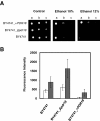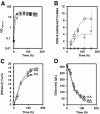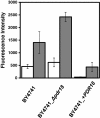Increased expression of the yeast multidrug resistance ABC transporter Pdr18 leads to increased ethanol tolerance and ethanol production in high gravity alcoholic fermentation
- PMID: 22839110
- PMCID: PMC3422159
- DOI: 10.1186/1475-2859-11-98
Increased expression of the yeast multidrug resistance ABC transporter Pdr18 leads to increased ethanol tolerance and ethanol production in high gravity alcoholic fermentation
Abstract
Background: The understanding of the molecular basis of yeast tolerance to ethanol may guide the design of rational strategies to increase process performance in industrial alcoholic fermentations. A set of 21 genes encoding multidrug transporters from the ATP-Binding Cassette (ABC) Superfamily and Major Facilitator Superfamily (MFS) in S. cerevisiae were scrutinized for a role in ethanol stress resistance.
Results: A yeast multidrug resistance ABC transporter encoded by the PDR18 gene, proposed to play a role in the incorporation of ergosterol in the yeast plasma membrane, was found to confer resistance to growth inhibitory concentrations of ethanol. PDR18 expression was seen to contribute to decreased ³H-ethanol intracellular concentrations and decreased plasma membrane permeabilization of yeast cells challenged with inhibitory ethanol concentrations. Given the increased tolerance to ethanol of cells expressing PDR18, the final concentration of ethanol produced during high gravity alcoholic fermentation by yeast cells devoid of PDR18 was lower than the final ethanol concentration produced by the corresponding parental strain. Moreover, an engineered yeast strain in which the PDR18 promoter was replaced in the genome by the stronger PDR5 promoter, leading to increased PDR18 mRNA levels during alcoholic fermentation, was able to attain a 6 % higher ethanol concentration and a 17 % higher ethanol production yield than the parental strain. The improved fermentative performance of yeast cells over-expressing PDR18 was found to correlate with their increased ethanol tolerance and ability to restrain plasma membrane permeabilization induced throughout high gravity fermentation.
Conclusions: PDR18 gene over-expression increases yeast ethanol tolerance and fermentation performance leading to the production of highly inhibitory concentrations of ethanol. PDR18 overexpression in industrial yeast strains appears to be a promising approach to improve alcoholic fermentation performance for sustainable bio-ethanol production.
Figures





Similar articles
-
The ABC transporter Pdr18 is required for yeast thermotolerance due to its role in ergosterol transport and plasma membrane properties.Environ Microbiol. 2021 Jan;23(1):69-80. doi: 10.1111/1462-2920.15253. Epub 2020 Oct 11. Environ Microbiol. 2021. PMID: 32985771 Free PMC article.
-
Pdr18 is involved in yeast response to acetic acid stress counteracting the decrease of plasma membrane ergosterol content and order.Sci Rep. 2018 May 18;8(1):7860. doi: 10.1038/s41598-018-26128-7. Sci Rep. 2018. PMID: 29777118 Free PMC article.
-
The yeast ABC transporter Pdr18 (ORF YNR070w) controls plasma membrane sterol composition, playing a role in multidrug resistance.Biochem J. 2011 Dec 1;440(2):195-202. doi: 10.1042/BJ20110876. Biochem J. 2011. PMID: 21831043 Free PMC article.
-
Effects of flavonoids on yeast ABC transporters activity.Fungal Biol. 2024 Dec;128(8 Pt A):2231-2241. doi: 10.1016/j.funbio.2024.09.004. Epub 2024 Sep 27. Fungal Biol. 2024. PMID: 39643390 Review.
-
How fungal multidrug transporters mediate hyper resistance through DNA amplification and mutation.Mol Microbiol. 2022 Jul;118(1-2):3-15. doi: 10.1111/mmi.14947. Epub 2022 Jun 6. Mol Microbiol. 2022. PMID: 35611562 Review.
Cited by
-
Biosynthesis of value-added bioproducts from hemicellulose of biomass through microbial metabolic engineering.Metab Eng Commun. 2022 Oct 18;15:e00211. doi: 10.1016/j.mec.2022.e00211. eCollection 2022 Dec. Metab Eng Commun. 2022. PMID: 36311477 Free PMC article. Review.
-
Quantitative 1H-NMR-metabolomics reveals extensive metabolic reprogramming and the effect of the aquaglyceroporin FPS1 in ethanol-stressed yeast cells.PLoS One. 2013;8(2):e55439. doi: 10.1371/journal.pone.0055439. Epub 2013 Feb 8. PLoS One. 2013. PMID: 23408980 Free PMC article.
-
Evaluation of divergent yeast genera for fermentation-associated stresses and identification of a robust sugarcane distillery waste isolate Saccharomyces cerevisiae NGY10 for lignocellulosic ethanol production in SHF and SSF.Biotechnol Biofuels. 2019 Feb 27;12:40. doi: 10.1186/s13068-019-1379-x. eCollection 2019. Biotechnol Biofuels. 2019. PMID: 30858877 Free PMC article.
-
Harnessing genetic diversity in Saccharomyces cerevisiae for fermentation of xylose in hydrolysates of alkaline hydrogen peroxide-pretreated biomass.Appl Environ Microbiol. 2014 Jan;80(2):540-54. doi: 10.1128/AEM.01885-13. Epub 2013 Nov 8. Appl Environ Microbiol. 2014. PMID: 24212571 Free PMC article.
-
Heterologous transporters from anaerobic fungi bolster fluoride tolerance in Saccharomyces cerevisiae.Metab Eng Commun. 2019 Apr 11;9:e00091. doi: 10.1016/j.mec.2019.e00091. eCollection 2019 Dec. Metab Eng Commun. 2019. PMID: 31016136 Free PMC article.
References
-
- Van Uden N. Ethanol toxicity and ethanol tolerance in yeasts. Ann Rep Ferm Process. 1985;8:11–58.
Publication types
MeSH terms
Substances
LinkOut - more resources
Full Text Sources
Molecular Biology Databases

